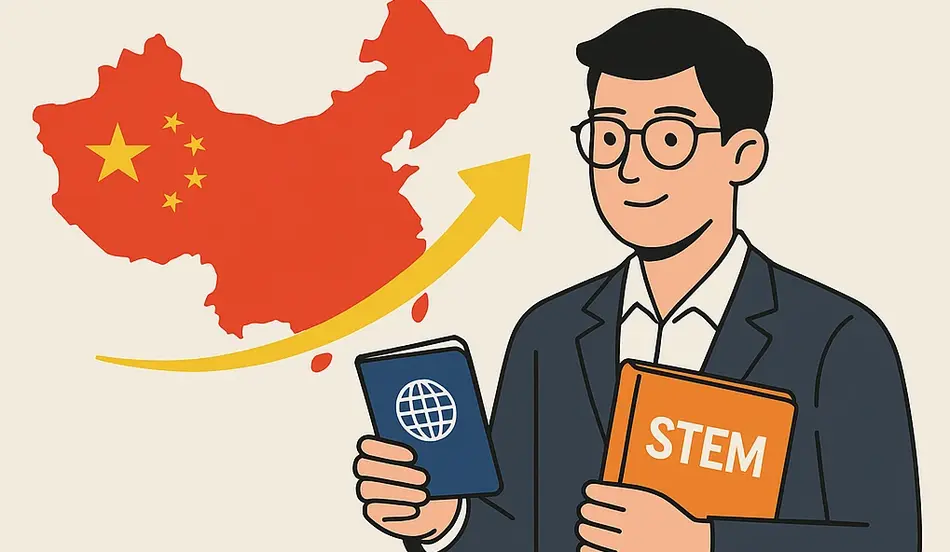China Tech Talent Visa is at the center of a heated debate as the country unveils a new visa category targeting STEM (science, technology, engineering, and mathematics) graduates from top global universities. This bold move, designed to attract the world’s brightest minds, comes at a time when China’s own youth face mounting challenges in the job market. In this article, we’ll break down what the K visa means, why it’s being introduced, and how it’s being received both at home and abroad.
What is the China Tech Talent Visa (K Visa)?
The K visa is a newly introduced category specifically aimed at attracting foreign STEM graduates from globally recognized universities and institutes. Valid for five years, this visa allows eligible holders to stay in China for up to 180 days each year. Unlike other high-skill worker visas in China, the K visa does not require an employment contract or employer nomination during those 180 days. This flexibility is designed to let foreign talent explore employment, academic, entrepreneurial, or other opportunities in China.
Key Features of the K Visa
- Open to STEM graduates from top global universities
- Valid for five years
- Allows up to 180 days of stay per year
- No employer nomination or contract required for the stay period
- Designed to attract high-level talent for employment, research, or entrepreneurship
This policy is seen by many as a direct response to recent changes in U.S. immigration policy, such as the proposed $100,000 fee for H1B visas, making China a more attractive destination for global talent.
Why is China Introducing the K Visa Now?
China’s decision to launch the K visa is driven by two main factors: global competition for tech talent and domestic demographic challenges.
Global Competition in Science and Technology
Chinese leaders, including President Xi Jinping, have emphasized that the competition between China and the United States is fundamentally a competition in science and technology. Attracting young talent from around the world is seen as essential for China to maintain and strengthen its position in this global race.
Demographic Shifts and Talent Shortages
China’s population is aging, and the effects of the one-child policy are becoming increasingly apparent. The country’s birth rate has dropped dramatically, with only around 8 million births expected this year—half the number from a decade ago. This demographic shift has created a pressing need for new talent, making the influx of skilled workers from abroad an attractive option.
Public Reaction: Support and Backlash
The introduction of the K visa has sparked a range of reactions within China. While the business community generally welcomes the move, there has been significant backlash from some segments of the public.
Concerns About Job Competition
Many young Chinese graduates are worried that the arrival of foreign STEM talent will make an already tough job market even more competitive. With the employment rate for university graduates in China at just 55% according to a 2024 report, these concerns are not unfounded.
National Identity and Xenophobia
Some critics argue that the new policy could undermine the “purity” of the Chinese nation or take jobs away from locals. Nationalistic sentiments, sometimes fueled by government narratives, have contributed to a degree of xenophobia and resistance to the policy.
- Social media backlash has included fears of job loss and cultural dilution.
- Some see the policy as favoring foreigners over local talent.
Historical Context of Immigration Policy in China
China has never been a major destination for immigrants, and the proportion of foreign-born residents remains very low. Previous attempts to introduce more immigrant-friendly policies have also met with resistance, but the government has sometimes adjusted its approach in response to public opinion.
Global STEM Talent in Demand
China’s new K Visa scheme highlights the fierce global competition for STEM workers. Employers everywhere can respond by attracting and retaining top international talent in science, tech, and engineering. Post your job on WhatJobs today and connect with skilled professionals ready to drive innovation worldwide.
Post a Job Free for 30 Days →Challenges and Uncertainties
While the K visa is ambitious, there are still many unanswered questions about how it will work in practice.
Defining “Top Global Universities”
One major uncertainty is how the government will define which universities and institutes qualify as “top global” for the purposes of the K visa. This lack of clarity could create confusion for potential applicants and for Chinese employers.
Language and Integration Barriers
Although the K visa is open to all qualified STEM graduates, language remains a significant barrier. For many foreign professionals, especially those who are not fluent in Mandarin, finding work or entrepreneurial opportunities in China can be challenging. In the short to medium term, the visa is most likely to attract overseas Chinese or those with some knowledge of the language and culture.
Policy Implementation and Future Adjustments
The rollout of the K visa is still in its early stages, and the final rules are being developed by the government and embassies worldwide. As with previous immigration policies, the government may adjust the program in response to public feedback and practical challenges.
The Broader Economic Context
China’s job market has been under pressure for several years, with economic growth slowing after the U.S.-China trade war, the COVID-19 pandemic, and other policy shifts such as the crackdown on private tutoring and the real estate sector. These factors have made it harder for young graduates to find stable employment.
Key Economic Factors Affecting Employment
- Slower economic growth post-trade war and pandemic
- Policy changes impacting major employment sectors
- Demographic decline reducing the pool of young workers
Is It Safe to Criticize the Policy?
While there have been vocal critiques of the K visa on Chinese social media, the government’s response to dissent has generally been measured, as long as criticism does not directly challenge the regime. In some cases, strong public opposition has led to policy adjustments, reflecting the sensitive nature of immigration in China.
Frequently Asked Questions (FAQ)
What is the China Tech Talent Visa and who is eligible?
The China Tech Talent Visa is a new five-year visa for STEM graduates from top global universities, allowing them to stay in China for up to 180 days per year without an employment contract.
Why did China introduce the China Tech Talent Visa?
China introduced the China Tech Talent Visa to attract global STEM talent, address demographic challenges, and compete with other countries in science and technology.
How does the China Tech Talent Visa differ from other Chinese work visas?
The China Tech Talent Visa does not require an employer nomination or contract for the 180-day stay period, offering more flexibility than traditional high-skill work visas.
What are the main concerns about the China Tech Talent Visa?
Concerns include increased job competition for local graduates, national identity issues, and uncertainties about how “top global universities” are defined.
Live Example: A User’s Perspective
As a recent engineering graduate in Shanghai, I’ve watched the rollout of the China Tech Talent Visa with mixed feelings. On one hand, I see the value in bringing in global talent to boost innovation and economic growth. On the other, I worry about how this will affect my own job prospects, especially when so many of my peers are struggling to find work. Some of my friends who studied abroad are considering applying for the K visa, hoping it will open new doors. For now, we’re all waiting to see how the policy will play out and what it will mean for our future careers.




